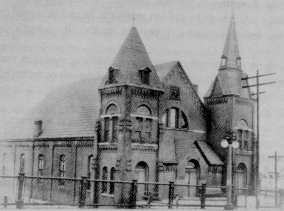 1828-29.
Under the Reverend Gwin's leadership, the African Mission continued to
grow and nourish until the membership numbered 819 members in 1833. The
Reverend John B. McFerrin's revivals also helped gain many black converts,
and his preaching increased the white membership to 550 souls. Because
of fear generated by Nat Turner's slave rebellion in Virginia and the spread
of northern abolitionist activity, the Sunday school and night meetings
ceased temporarily in 1836. At least two black preachers actively participated
in the mission. One named Simon, a slave of African origins, gained his
freedom and preached at the mission until his death in 1847. The mission's
membership stood at 810 persons in 1837. The dispute over slavery caused
the southern churches to organize the Methodist Episcopal Church, South,
in 1846. This new convention immediately approved the separation of the
"African Mission" from the McKendree Church.
1828-29.
Under the Reverend Gwin's leadership, the African Mission continued to
grow and nourish until the membership numbered 819 members in 1833. The
Reverend John B. McFerrin's revivals also helped gain many black converts,
and his preaching increased the white membership to 550 souls. Because
of fear generated by Nat Turner's slave rebellion in Virginia and the spread
of northern abolitionist activity, the Sunday school and night meetings
ceased temporarily in 1836. At least two black preachers actively participated
in the mission. One named Simon, a slave of African origins, gained his
freedom and preached at the mission until his death in 1847. The mission's
membership stood at 810 persons in 1837. The dispute over slavery caused
the southern churches to organize the Methodist Episcopal Church, South,
in 1846. This new convention immediately approved the separation of the
"African Mission" from the McKendree Church. Nashville's black Methodists continued to worship at the Sulphur Springs location until l851, when they purchased a lot to build a new church on Hynes Street and McCreary (Eleventh Avenue, North), near the Nashville-Chattanooga Railway Depot. Capers Church became the first local structure built exclusively for a black church. The new building was a large brick edifice paid for through the sale of the African Mission's old church, "the old camp grounds," and donations from citizens. On December 25, 1853, the dedicatory sermon was preached by Dr. John B. McFerrin, and the new building was officially named Capers Chapel in honor of Bishop William C. Capers. White ministers from the McKendree congregation continued to supervise the black mission.
The Civil War and the Union army's occupation of Nashville (in February of 1862) disrupted religious life. The Reverend Elisha Carr was pastor of the Capers congregation during these turbulent times when black preachers gradually assumed control of the Capers Church. In 1863, they permitted a United Presbyterian Church missionary from the North, the Reverend J. G. McKee, to establish a school in the building. The Union army confiscated the Capers building to use as a brass shop, because the structure lay in the midst of the railyard complex. After the Battle of Murfreesboro in late 1863, the army converted the Capers Church to a military hospital.
In December of 1863, Bishop Daniel A. Payne of the African Methodist Episcopal (AME) Church arrived in Nashville to organize churches. On December 15, 1863, the Reverend Napoleon Merry and a committee of seven persons applied for membership in the African Methodist Episcopal Church. The blacks' petition to Payne stated that the Methodist Episcopal Church, South, acted disloyally to the United States. Payne accepted the petition and established St. John AME Church. However, when the war ended in 1865, most Capers Church members and the church's property remained with the white Methodist Episcopal Church, South.
After 1866, the independent Capers Church became part of the Memphis Colored Conference (founded in November of 1867). The Colored Methodist Episcopal Church was organized in Jackson, Tennessee, on December 15, 1870. The Conference's first bishop, William Henry Miles, preached at Capers on January 1, 1871 -- Emancipation Day. Capers Church produced two elected bishops: the Reverend Elias Cottrell (1878-80) and the Reverend George Stewart (1885-87). In 1887, the congregation tore down the building on Lynes and McCreary and erected a new edifice at Twelfth and Church streets: "the church on the viaduct." The Reverend J. M. Mitchell completed the basement. Years later, the Reverend G. I. Jackson's congregation finished the structure and renamed the church "Jackson Temple." Eventually, the name was changed back to Capers Chapel.
In 1924, the city condemned the property to raise the viaduct. The congregation bought land at 319 Fifteenth Avenue, North, and completed a new building in 1925. McKissack and McKissack Architects designed and built the church building. Two more pastors were elevated to the bishopric: the Reverend P. Randolph Shy (1937-38) and the Reverend Joseph A. Johnson, Jr. (1954-59). The Reverend Dr. Charles E. Winfrey, Sr., directed the listing of the church building in the National Register of Historic Places in 1985.